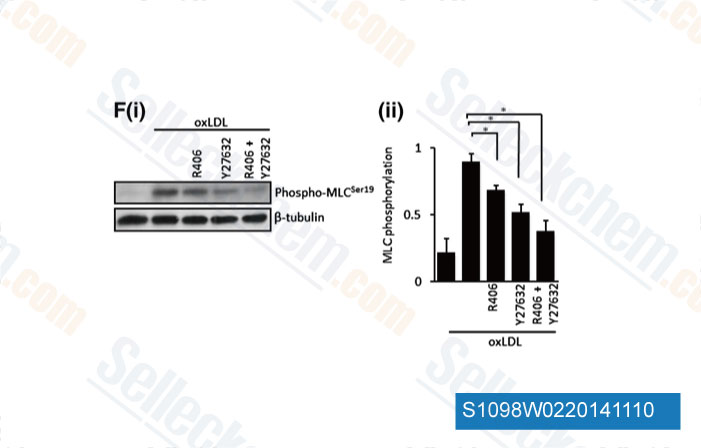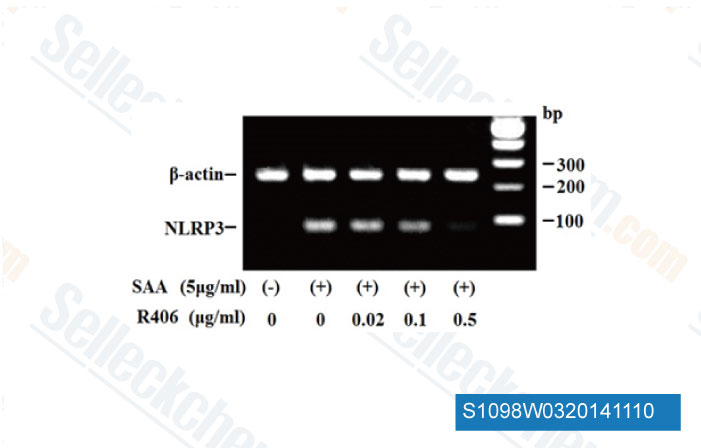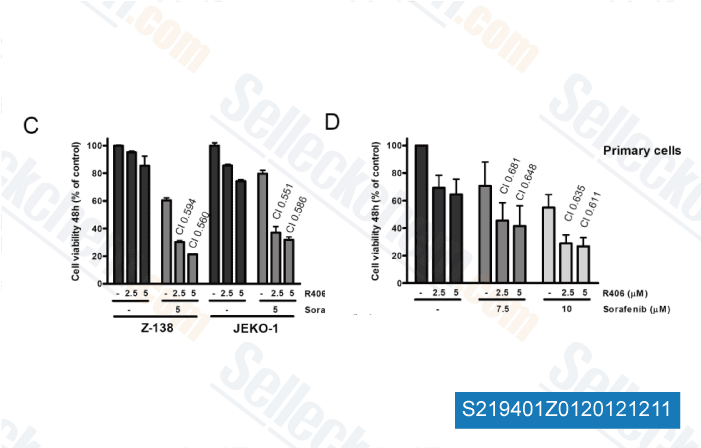|
Toll Free: (877) 796-6397 -- USA and Canada only -- |
Fax: +1-832-582-8590 Orders: +1-832-582-8158 |
Tech Support: +1-832-582-8158 Ext:3 Please provide your Order Number in the email. |
Technical Data
| Formula | C22H23FN6O5.C6H6O3S |
|||
| Molecular Weight | 628.63 | CAS No. | 841290-81-1 | |
| Solubility (25°C)* | In vitro | DMSO | 100 mg/mL (159.07 mM) | |
| Ethanol | 38 mg/mL (60.44 mM) | |||
| Water | Insoluble | |||
|
* <1 mg/ml means slightly soluble or insoluble. * Please note that Selleck tests the solubility of all compounds in-house, and the actual solubility may differ slightly from published values. This is normal and is due to slight batch-to-batch variations. * Room temperature shipping (Stability testing shows this product can be shipped without any cooling measures.) |
||||
Preparing Stock Solutions
Biological Activity
| Description | R406(R406 besylate) is a potent Syk inhibitor with IC50 of 41 nM in cell-free assays, strongly inhibits Syk but not Lyn, 5-fold less potent to Flt3. R406 induces apoptosis. Phase 1. | ||||
|---|---|---|---|---|---|
| Targets |
|
||||
| In vitro | R406 is a potent inhibitor of immunoglobulin E (IgE)- and IgG-mediated activation of Fc receptor signaling. R406 inhibits the anti-IgE-induced production and release of LTC4 and cytokines and chemokines, including TNFα, IL-8, and GM-CSF. R406 inhibits phosphorylation of Syk substrate linker for activation of T cells in mast cells and B-cell linker protein/SLP65 in B cells. R406 binds to the ATP binding pocket of Syk and inhibits its kinase activity as an ATP-competitive inhibitor with Ki of 30 nM. R406 blocks Syk-dependent FcR-mediated activation of monocytes/macrophages and neutrophils and Bcr-mediated activation of B lymphocytes. [1] R406 significantly induces chronic lymphocytic leukemia (CLL) cell apoptosis in nurselike cells cocultures and blocks CCL3 and CCL4 secretion by CLL cells in response to B-cell antigen receptor (Bcr) triggering. [2] R406 is a potent inhibitor of platelet signaling and functions initiated by FcγRIIA cross-linking by specific antibodies or by sera from HIT patients. [3] |
||||
| In vivo | R406 reduces cutaneous reverse passive Arthus reaction by approximately 86% at 5 mg/kg in prophylactic treated mice. R406 also shows efficacy in inhibiting paw inflammation in antibody-induced arthritis mouse models. [1] R406 does not adversely affect macrophage or neutrophil function in innate immune responses and has minimal functional immunotoxicity notwithstanding its lymphocytopenic effect. [4] |
||||
| Features | Lead drug candidate for rheumatoid arthritis. |
Protocol (from reference)
| Kinase Assay: |
|
|---|---|
| Animal Study: |
|
References
Customer Product Validation

-
Data from [Data independently produced by Blood, 2014, 122(4), 580-9]

-
Data from [Data independently produced by J Clin Invest, 2014, 124(11), 5074-84]

-
Data from [Data independently produced by PLoS One, 2014, 9(5), e96703]

-
Data from [Clin Cancer Res, 2013, 19, 586-597]
Selleck's R406 has been cited by 112 publications
| Bactericidal/permeability-increasing protein instructs dendritic cells to elicit Th22 cell response [ Cell Rep, 2024, 43(3):113929] | PubMed: 38457343 |
| B1-cell-produced anti-phosphatidylserine antibodies contribute to lupus nephritis development via TLR-mediated Syk activation [ Cell Mol Immunol, 2023, 1-14.] | PubMed: 37291237 |
| Loss of NF1 in Melanoma Confers Sensitivity to SYK Kinase Inhibition [ Cancer Res, 2023, 83(2):316-331] | PubMed: 36409827 |
| Adjuvant activity of tubeimosides by mediating the local immune microenvironment [ Front Immunol, 2023, 14:1108244] | PubMed: 36845089 |
| Integrated single-cell (phospho-)protein and RNA detection uncovers phenotypic characteristics and active signal transduction of human antibody secreting cells [ Mol Cell Proteomics, 2023, S1535-9476(23)00001-4] | PubMed: 36623694 |
| Dual RNA-Sequencing and Liquid Chromatography-Mass Spectrometry Unveil Specific Insights on the Pathogenicity of Trichophyton mentagrophytes Complex [ J Invest Dermatol, 2023, 143(3):470-479.e6] | PubMed: 38295003 |
| Multiparametric Profiling of Neutrophil Function via a High-Throughput Flow Cytometry-Based Assay [ Cells, 2023, 12(5)743] | PubMed: 36899878 |
| Endothelial TREM-1 receptor regulates the blood-brain barrier integrity after intracerebral hemorrhage in mice via SYK/β-catenin signaling [ CNS Neurosci Ther, 2023, 10.1111/cns.14255] | PubMed: 37170484 |
| Toll-like receptor 4 and Syk kinase shape dendritic cell-induced immune activation to major house dust mite allergens [ Front Med (Lausanne), 2023, 10:1105538] | PubMed: 37614946 |
| Toll-like receptor 4 and Syk kinase shape dendritic cell-induced immune activation to major house dust mite allergens [ Front Med (Lausanne), 2023, 10:1105538] | PubMed: 37614946 |
RETURN POLICY
Selleck Chemical’s Unconditional Return Policy ensures a smooth online shopping experience for our customers. If you are in any way unsatisfied with your purchase, you may return any item(s) within 7 days of receiving it. In the event of product quality issues, either protocol related or product related problems, you may return any item(s) within 365 days from the original purchase date. Please follow the instructions below when returning products.
SHIPPING AND STORAGE
Selleck products are transported at room temperature. If you receive the product at room temperature, please rest assured, the Selleck Quality Inspection Department has conducted experiments to verify that the normal temperature placement of one month will not affect the biological activity of powder products. After collecting, please store the product according to the requirements described in the datasheet. Most Selleck products are stable under the recommended conditions.
NOT FOR HUMAN, VETERINARY DIAGNOSTIC OR THERAPEUTIC USE.
